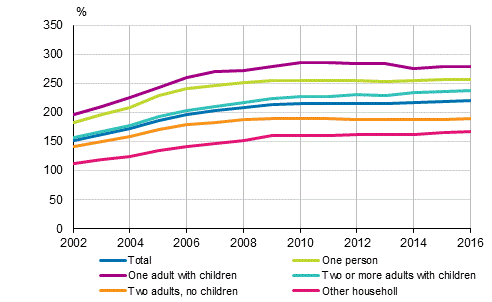Published: 25 January 2018
Household-dwelling units with housing loans are EUR 97,220 in debt
In 2016, household-dwelling units with housing loans had, on average, 220 per cent of their disposable annual income in debts. Single-supporter families had most debt compared to their income, 279 per cent, as did household-dwelling units with one adult, 256 per cent. The indebtedness ratio of two-supporter families with children was also higher than average, 237 per cent. The average size of a housing loan per household-dwelling unit with a housing loan was EUR 97,220, which was 1.2 per cent more than in 2015.
Rates of indebtedness of household-dwelling units with housing loans by type of family in 2002 to 2016, %

There were 1.4 million indebted household-dwelling units in 2016. Their total debt amounted to EUR 117.8 billion. Of the debts, EUR 85.5 billion were housing loans, EUR 7.2 billion were debts taken out for business purposes and EUR 25.1 billion were other debts, which include, for example, debts for consumption and larger purchases. In total, debts grew by 2.2 per cent in real terms from the previous year. Housing loans grew by 1.5 per cent and loans charged on business activities or a source of income by 2.7 per cent. Other debts grew most from 2015, by 4.7 per cent.
Two-supporter families with children were the most common housing loan holders. The housing loans of families with children were higher than those of childless household-dwelling units. Two-supporter families with children had, on average, EUR 130,790 in housing loans and single-supporter families EUR 88,660. Childless household-dwelling units had less housing loans but their indebtedness varied considerably by age. All childless household-dwelling units with two adults had, on average, EUR 83,590 in housing loans and one person household-dwelling units EUR 65,980.
Household-dwelling units in Åland, Greater Helsinki and elsewhere in Helsinki-Uusimaa had most debt compared to their income. Forty-one per cent of the household-dwelling units with housing loans in Åland, 36 per cent in Greater Helsinki and 34 per cent elsewhere in Helsinki-Uusimaa had debts that were at least triple compared with their annual income. Elsewhere in Finland, one-quarter of household-dwelling units with housing loans had debts that were at least triple compared with their annual income.
Relative to income, debt was higher the lower the income of the household-dwelling unit was. Of the household-dwelling units belonging to the lowest income quintile, 44 per cent had debts that were at least triple compared with their annual income, while 23 per cent of the household-dwelling units in the highest income quintile had that much debt. On average, household-dwelling units belonging to the lowest income quintile had EUR 64,990 in housing loans and those in the highest income quintile EUR 124,590.
In 2016, household-dwelling units paid EUR 1.7 billion in interests, which was ten per cent less than twelve months earlier. The interest expenses per indebted household-dwelling unit were EUR 1,190. On average, household-dwelling units with housing loans paid EUR 1,090 in interests on their housing loans, which was 14 per cent less than in 2015. Compared with 2002, household-dwelling units’ interest expenses were, in real terms, 40 per cent lower, even though their debts have more than doubled over the same period.
Source: Indebtedness 2016. Statistics Finland
Inquiries: Timo Matala 029 551 3422
Director in charge: Jari Tarkoma
Publication in pdf-format (166.6 kB)
- Tables
-
Tables in databases
Pick the data you need into tables, view the data as graphs, or download the data for your use.
Updated 25.1.2018
Official Statistics of Finland (OSF):
Indebtedness [e-publication].
ISSN=2489-3285. 2016. Helsinki: Statistics Finland [referred: 19.12.2025].
Access method: http://stat.fi/til/velk/2016/velk_2016_2018-01-25_tie_002_en.html

